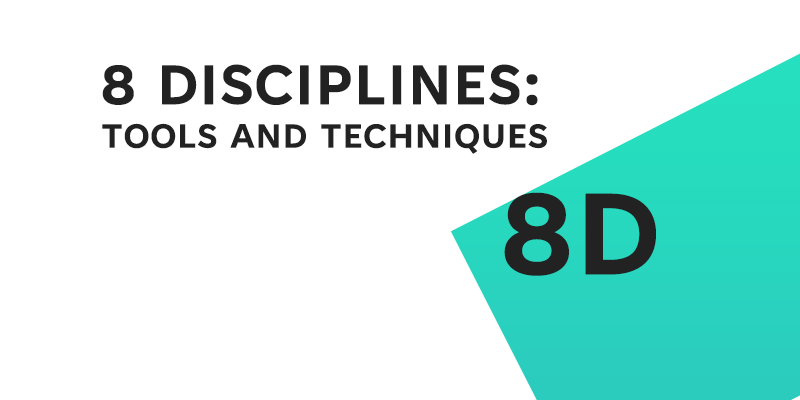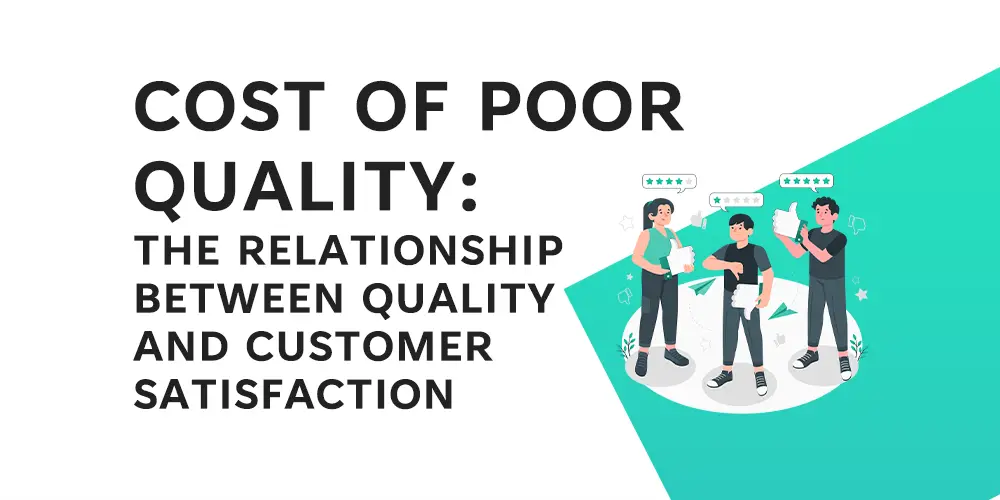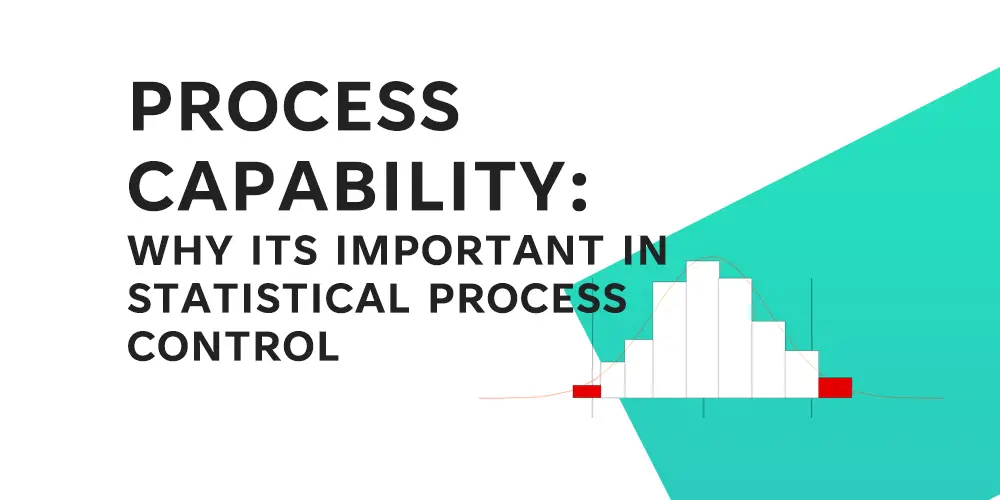Are you grappling with recurring problems in your organization and searching for a structured way to resolve them once and for all? Look no further than the 8D Problem-Solving Methodology—a comprehensive eight-step approach initially developed in the automotive industry but widely applicable across various sectors.
This systematic method not only aids in diagnosing the root cause of a problem but also offers a roadmap for effective solutions. However, maximizing the potential of the 8D process involves more than just following its steps. It requires the strategic application of specific tools and techniques at each stage. In this educational blog post, we will guide you through the tools and techniques best suited for each of the 8 Disciplines, empowering you to turn challenges into opportunities for improvement. So, let’s delve into this toolkit and make your problem-solving journey as efficient and effective as possible.
D1: Form a Team
The first step in the 8D Problem-Solving Methodology is to form a cross-functional team. A well-assembled team is the backbone of any successful problem-solving initiative. While it may be tempting to rush through this step, investing time and effort here can pay dividends later. Let’s explore some of the key tools that can assist you in forming an effective team.
Suggested Tools:
1. RACI Matrix
The RACI Matrix is an invaluable tool for defining roles and responsibilities within the team. The acronym stands for Responsible, Accountable, Consulted, and Informed. By using this matrix, you can clearly specify:
- Responsible: Who is doing the task?
- Accountable: Who is ensuring the task gets completed?
- Consulted: Who needs to provide input?
- Informed: Who needs to know the outcome?
Clear delineation of roles prevents overlap, ensures accountability, and minimizes confusion later in the process.
2. Skills Matrix
Selecting team members with the right set of skills is crucial. A Skills Matrix can help you in this aspect by providing a visual representation of each potential team member’s skills and competencies. You can rate skills on a scale (e.g., 1 to 5) and identify gaps that need to be filled. The matrix can include both technical and soft skills like communication, leadership, and domain expertise.
Key Takeaway:
An effective problem-solving team is not just a group of people; it’s a carefully chosen set of individuals with complementary skills and clearly defined roles. Utilizing tools like the RACI Matrix and Skills Matrix can immensely help in this phase, setting the stage for a successful problem-solving endeavor.
By taking the time to carefully form your team and define everyone’s roles and responsibilities, you lay a strong foundation for the rest of the 8D process. Remember, a well-prepared team is more likely to find sustainable solutions and less likely to encounter roadblocks down the line.
D2: Define the Problem
After assembling a competent team, the next critical step in the 8D Problem-Solving Methodology is defining the problem. A well-defined problem serves as a clear roadmap, guiding your team in the right direction from the start. Ambiguity at this stage can lead to misdirection and wasted resources. So what tools can help you clearly and concisely articulate the problem?
Suggested Tools:
1. 5W2H Method
The 5W2H method is a powerful tool for problem definition. It involves asking a series of questions to gain a comprehensive understanding of the issue at hand. These questions include:
- Who is involved or affected?
- What exactly is the problem?
- When did it occur?
- Where did it occur?
- Why is it a problem?
- How did it happen?
- How much is it affecting?
By systematically answering these questions, you define the problem in a manner that is both comprehensive and easily understandable for everyone involved.

2. SMART Criteria
The SMART criteria focus on setting specific, measurable, achievable, relevant, and time-bound goals for the problem-solving effort. This approach helps ensure that the problem is clearly defined and that the team has a focused, achievable objective to aim for.
- Specific: Clearly define what needs to be achieved.
- Measurable: Set criteria for measuring progress and success.
- Achievable: Ensure the goals are realistic given the resources.
- Relevant: Align the goals with broader organizational objectives.
- Time-bound: Establish a timeline for solving the problem.

Key Takeaway:
Defining the problem is not a mere formality; it is a necessity for effective problem-solving. A well-defined problem ensures that everyone is on the same page and focused on the right issues. Tools like the 5W2H method and SMART criteria offer invaluable frameworks for achieving this clarity. They help dissect the problem into manageable parts, setting the stage for focused root cause analysis.
D3: Contain the Problem
Once you have a team in place and a well-defined problem, the next step in the 8D Problem-Solving Methodology is containment. This stage is often overlooked but is crucial for limiting the damage and preventing the problem from exacerbating. Containment actions are essentially short-term solutions aimed at halting the spread of the issue while you work on finding a permanent fix. Let’s delve into some tools that can guide you in this phase.
Suggested Tools:
1. Check Sheet
A Check Sheet is a simple yet effective tool for collecting and organizing data. It’s often a paper-and-pencil tool that allows for quick data collection in real-time. For example, if the problem is a high rate of defects in a manufacturing line, a Check Sheet could be used to tally the number of defects by type or time of occurrence. This provides valuable insights into the scope and pattern of the problem, aiding in containment.
2. SWIFT Checklist
The SWIFT (Short Window Immediate Fix Technique) Checklist is a tool designed for rapid assessment. It outlines immediate actions that should be taken to contain the issue. The checklist could include questions like:
- Are there safety issues that need immediate attention?
- Can the affected products be quarantined?
- Do stakeholders need to be informed?
By quickly going through the SWIFT Checklist, you can prioritize the most critical containment actions and implement them without delay.
Key Takeaway:
Containment is not just about putting a temporary fix; it’s about preventing the problem from causing further harm or affecting other processes. Tools like the Check Sheet and SWIFT Checklist can be instrumental in quickly assessing the situation and implementing immediate containment actions.
Utilizing these tools allows you to create a rapid response mechanism, thereby minimizing the impact and scope of the problem. As you transition to finding a long-term solution, these containment measures ensure that the situation remains under control.
D4: Root Cause Analysis
Reaching the root cause analysis stage in the 8D Problem-Solving Methodology signifies a pivotal moment. Here, you transition from understanding and containing the problem to actually solving it. Identifying the root cause(s) is fundamental to ensuring that the issue doesn’t recur. While containment measures provide short-term relief, it’s the root cause analysis that offers a long-term solution. Let’s examine some essential tools that can assist in uncovering the underlying issues.
Suggested Tools:
1. 5 Whys
The “5 Whys” is a powerful questioning technique that helps you drill down into the root cause of a problem by asking “Why?” repeatedly. Often, the apparent issue is just a symptom of a deeper problem. The 5 Whys technique encourages you to move beyond the symptoms and discover the underlying cause.
For instance, if the issue is frequent machine breakdowns, asking “Why?” might reveal:
- Why is the machine breaking down? Because of excessive wear and tear.
- Why is there excessive wear and tear? Because maintenance isn’t performed regularly.
- Why isn’t maintenance regular? Because there’s no schedule.
- Why is there no schedule? Because it was never made a priority.
- Why was it never a priority? Because of a lack of awareness about its importance.

2. Pareto Analysis
Pareto Analysis is based on the Pareto Principle, which states that 80% of problems are often due to 20% of causes. By identifying and focusing on these significant causes, you can resolve the majority of issues with minimum effort. Pareto Analysis typically involves collecting data and creating a Pareto Chart to visualize which factors are most impactful.

3. Fishbone Diagram (Ishikawa)
Though also used in problem definition, the Fishbone Diagram is invaluable for root cause analysis as well. It allows you to categorize potential causes and delve deeper into each, often in combination with other tools like the 5 Whys or Pareto Analysis.

Key Takeaway:
Identifying the root cause is not merely a step in the process; it’s the cornerstone for effective corrective action. Tools like the 5 Whys, Pareto Analysis, and Fishbone Diagram provide a structured approach to dig deep into the problem and unearth its roots. Only by understanding the root cause can you implement solutions that are not just quick fixes but long-lasting remedies.
D5: Choose and Verify Corrective Actions
After identifying the root cause of the problem, the next logical step in the 8D Problem-Solving Methodology is to choose and verify corrective actions. It’s crucial to remember that not all solutions are created equal. Some may offer a quick fix but not a long-lasting one, while others could inadvertently introduce new issues. Therefore, this stage involves a delicate balance of selecting an effective solution and ensuring it doesn’t have unintended consequences. Let’s explore some of the tools that can guide you in making informed decisions.
Suggested Tools:
1. FMEA (Failure Mode and Effects Analysis)
FMEA is a structured approach for evaluating the potential failure modes of a proposed solution and their impact. By predicting how things could go wrong, you can proactively address these issues before they occur. The FMEA process involves the identification of failure modes, assessment of their effects, and prioritization based on their severity, occurrence, and detectability. This prioritization helps you focus your resources where they’ll be most effective.
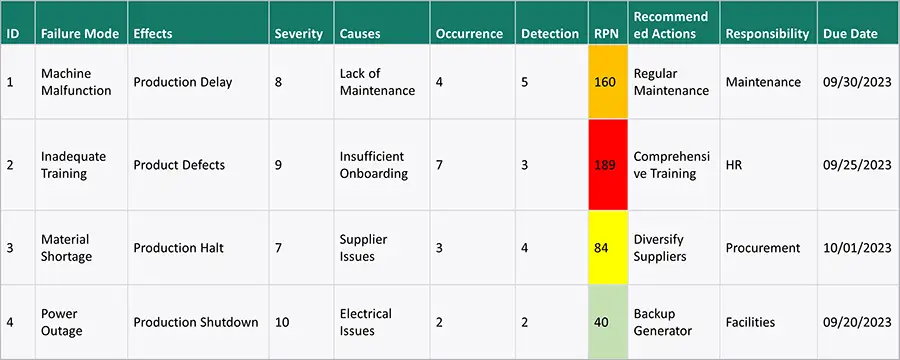
2. Pilot Testing
Before implementing a corrective action on a full scale, it’s prudent to test it on a smaller scale to verify its effectiveness. Pilot testing allows you to:
- Evaluate the impact of the solution without large-scale commitment.
- Identify any adjustments or optimizations needed.
- Collect data to validate the solution’s efficacy.
Pilot tests should be carefully designed to mimic the conditions under which the full-scale implementation will occur. This way, the results are indicative of what you can expect in the broader application.
Key Takeaway:
Choosing a corrective action is a significant milestone, but verifying its effectiveness is equally crucial. Tools like FMEA and Pilot Testing enable you to rigorously evaluate your chosen solutions, mitigating risks and ensuring that the corrective actions will address the root cause without creating new problems.
By diligently applying these tools, you not only select the right corrective action but also build a robust verification mechanism. This two-pronged approach ensures that your solution is not just theoretically sound but practically effective as well.
D6: Implement Corrective Actions
Reaching the implementation phase of the 8D Problem-Solving Methodology is a big step. You’ve formed a team, defined the problem, contained it, identified its root cause, and chosen and verified corrective actions. Now, it’s time to put those actions into play. However, effective implementation is easier said than done. It requires meticulous planning, execution, and monitoring to ensure the corrective actions yield the desired results. Let’s look at some of the tools that can help you master this crucial stage.
Suggested Tools:
1. Gantt Chart
A Gantt Chart is an excellent tool for project planning and tracking. It provides a visual timeline for the tasks involved in implementing the corrective actions. The chart specifies:
- Task names
- Start and end dates
- Responsible parties
- Dependencies between tasks
This visual representation makes it easier to manage resources and timelines, ensuring that implementation stays on track.

2. PDCA (Plan-Do-Check-Act)
The PDCA cycle is a four-step approach for implementing changes in a controlled manner. Each step serves a specific purpose:
- Plan: Establish the objectives, processes, and metrics for the corrective action.
- Do: Execute the plan on a small scale initially.
- Check: Measure the outcomes against the planned objectives and analyze the results.
- Act: Make adjustments based on the analysis and either scale the implementation or revisit the plan.
By cycling through these steps, you can continually refine your implementation approach, ensuring it aligns with your objectives.
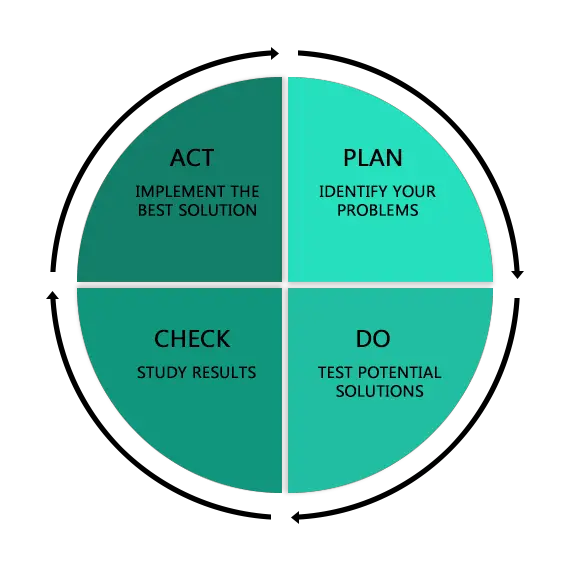
Key Takeaway:
Implementation is the stage where your problem-solving efforts come to fruition, but it’s not a one-and-done deal. Effective implementation requires continuous monitoring and adjustment. Tools like the Gantt Chart and PDCA cycle provide you with the means to implement corrective actions in a structured, controlled, and measurable way.
Remember, a well-planned implementation not only solves the current problem but also equips your organization with the knowledge and experience to tackle future challenges more effectively.
D7: Prevent Recurrence
Successfully implementing corrective actions is an accomplishment, but the 8D Problem-Solving journey doesn’t end there. The next crucial step is to ensure that the problem doesn’t recur. This phase focuses on institutionalizing the improvements you’ve made, ensuring they are sustainable over the long term. It involves both documentation of new best practices and ongoing monitoring. Let’s explore the tools that can help solidify these new standards.
Suggested Tools:
1. Standard Work
Standard Work refers to the documentation of the new best practices that led to the resolution of the problem. These could be new procedures, guidelines, or checklists that need to be followed. Standard Work serves multiple purposes:
- It provides a clear and easy-to-follow guide for team members.
- It ensures that the successful corrective actions are repeated, thereby making the improvements sustainable.
- It serves as a training resource for new employees or for refresher training for existing staff.

2. Control Charts
Control Charts are used to monitor process performance over time. These charts can help you:
- Identify any variations in the process.
- Distinguish between normal variations and those that need attention.
- Trigger corrective actions if the process goes out of the defined control limits.
Regularly updating and reviewing the Control Charts ensures that you catch any deviations before they turn into bigger problems.

Key Takeaway:
Prevention is indeed better than cure. The most effective problem-solving initiatives are those that not only solve the immediate issue but also prevent its recurrence. Tools like Standard Work and Control Charts offer a structured way to document and monitor the improvements, making them a part of your organizational culture.
By diligently using these tools, you not only secure the gains made but also create a proactive environment where potential issues are identified and addressed before they escalate.
D8: Congratulate the Team
The final step in the 8D Problem-Solving Methodology is often the most overlooked but is crucial for long-term success: congratulating the team. After navigating through a complex problem-solving journey, taking a moment to acknowledge and celebrate the hard work is vital. It not only boosts morale but also encourages a culture of continuous improvement. Let’s delve into some tools and practices that can help you effectively close out your problem-solving initiative.
Suggested Tools:
1. Recognition and Rewards
Acknowledging the hard work and dedication of the team is essential for maintaining a motivated and engaged workforce. Recognition can take various forms:
- Public acknowledgment in team meetings or company-wide announcements.
- Certificates or plaques to commemorate the achievement.
- Small rewards or bonuses, where appropriate.
This recognition serves as a reminder that efforts are appreciated, which in turn fosters a positive work environment.
2. Lessons Learned Document
Closing out a problem-solving initiative offers a prime opportunity to capture what worked and what didn’t. A Lessons Learned Document serves this purpose:
- It details the challenges faced, how they were overcome, and any roadblocks encountered.
- It captures best practices for future reference.
- It identifies areas for improvement, offering a starting point for future problem-solving endeavors.
Sharing this document organization-wide can serve as a valuable resource for other teams facing similar challenges.

Key Takeaway:
A job well done indeed deserves recognition, but it also lays the groundwork for future improvements. Tools like Recognition and Rewards and the Lessons Learned Document not only celebrate success but also institutionalize the knowledge gained. This twofold approach not only marks the successful completion of one problem-solving initiative but sets the stage for ongoing improvements and future successes.
By taking the time to celebrate and reflect, you not only acknowledge the efforts made but also capture valuable insights that can guide your organization’s continuous improvement journey.
Conclusion
Successfully navigating the 8D Problem-Solving Methodology is a commendable achievement, but the journey doesn’t end with implementing a solution. Each step, from forming a team to congratulating them, is a building block in your organization’s culture of continuous improvement.
Employing specific tools like RACI Matrix, 5 Whys, FMEA, and Control Charts at different stages ensures that your problem-solving efforts are not just effective but also sustainable. These tools offer more than just a way to tackle issues; they provide a structured approach to learning from them. Remember, the goal isn’t just to solve a single problem but to refine a system that becomes increasingly resilient and efficient over time. So, take a moment to celebrate your achievements, and then gear up for your next challenge, armed with the knowledge and tools that will make your problem-solving journey even more impactful.
References
- Sharma, M., Sharma, S. and Sahni, S., 2020. Structured Problem Solving: combined approach using 8D and Six Sigma case study. Engineering Management in Production and Services, 12(1), pp.57-69.
- Broday, E.E. and Júnior, P.P.A., 2013. Application of a quality management tool (8D) for solving industrial problems. Independent Journal of Management & Production, 4(2), pp.377-390.
- Engineer, A.T.D., 2016. Managing project using 8D technique. Management, 7(6), p.67œ76.

